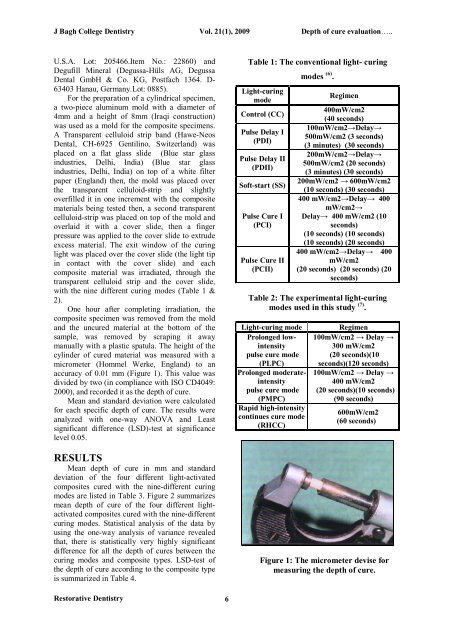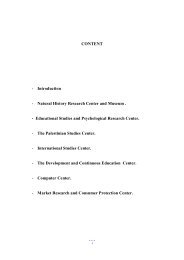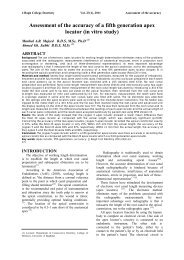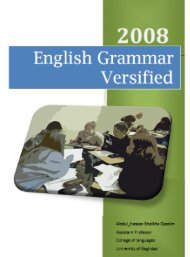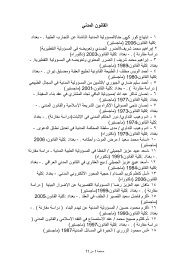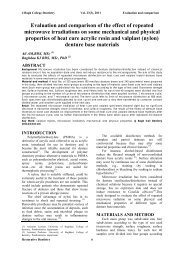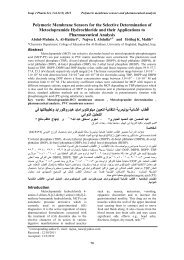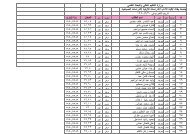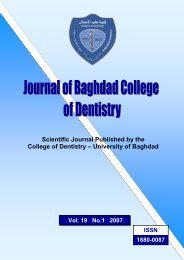Vol 21 No. 1
Vol 21 No. 1
Vol 21 No. 1
Create successful ePaper yourself
Turn your PDF publications into a flip-book with our unique Google optimized e-Paper software.
J Bagh College Dentistry <strong>Vol</strong>. <strong>21</strong>(1), 2009 Depth of cure evaluation…..<br />
U.S.A. Lot: 205466.Item <strong>No</strong>.: 22860) and<br />
Degufill Mineral (Degussa-Hüls AG, Degussa<br />
Dental GmbH & Co. KG, Postfach 1364. D-<br />
63403 Hanau, Germany.Lot: 0885).<br />
For the preparation of a cylindrical specimen,<br />
a two-piece aluminum mold with a diameter of<br />
4mm and a height of 8mm (Iraqi construction)<br />
was used as a mold for the composite specimens.<br />
A Transparent celluloid strip band (Hawe-Neos<br />
Dental, CH-6925 Gentilino, Switzerland) was<br />
placed on a flat glass slide (Blue star glass<br />
industries, Delhi, India) (Blue star glass<br />
industries, Delhi, India) on top of a white filter<br />
paper (England) then, the mold was placed over<br />
the transparent celluloid-strip and slightly<br />
overfilled it in one increment with the composite<br />
materials being tested then, a second transparent<br />
celluloid-strip was placed on top of the mold and<br />
overlaid it with a cover slide, then a finger<br />
pressure was applied to the cover slide to extrude<br />
excess material. The exit window of the curing<br />
light was placed over the cover slide (the light tip<br />
in contact with the cover slide) and each<br />
composite material was irradiated, through the<br />
transparent celluloid strip and the cover slide,<br />
with the nine different curing modes (Table 1 &<br />
2).<br />
One hour after completing irradiation, the<br />
composite specimen was removed from the mold<br />
and the uncured material at the bottom of the<br />
sample, was removed by scraping it away<br />
manually with a plastic spatula. The height of the<br />
cylinder of cured material was measured with a<br />
micrometer (Hommel Werke, England) to an<br />
accuracy of 0.01 mm (Figure 1). This value was<br />
divided by two (in compliance with ISO CD4049:<br />
2000), and recorded it as the depth of cure.<br />
Mean and standard deviation were calculated<br />
for each specific depth of cure. The results were<br />
analyzed with one-way ANOVA and Least<br />
significant difference (LSD)-test at significance<br />
level 0.05.<br />
RESULTS<br />
Mean depth of cure in mm and standard<br />
deviation of the four different light-activated<br />
composites cured with the nine-different curing<br />
modes are listed in Table 3. Figure 2 summarizes<br />
mean depth of cure of the four different lightactivated<br />
composites cured with the nine-different<br />
curing modes. Statistical analysis of the data by<br />
using the one-way analysis of variance revealed<br />
that, there is statistically very highly significant<br />
difference for all the depth of cures between the<br />
curing modes and composite types. LSD-test of<br />
the depth of cure according to the composite type<br />
is summarized in Table 4.<br />
Table 1: The conventional light- curing<br />
Light-curing<br />
mode<br />
Control (CC)<br />
Pulse Delay I<br />
(PDI)<br />
Pulse Delay II<br />
(PDII)<br />
Soft-start (SS)<br />
Pulse Cure I<br />
(PCI)<br />
Pulse Cure II<br />
(PCII)<br />
modes (6) .<br />
Regimen<br />
400mW/cm2<br />
(40 seconds)<br />
100mW/cm2→Delay→<br />
500mW/cm2 (3 seconds)<br />
(3 minutes) (30 seconds)<br />
200mW/cm2→Delay→<br />
500mW/cm2 (20 seconds)<br />
(3 minutes) (30 seconds)<br />
200mW/cm2 → 600mW/cm2<br />
(10 seconds) (30 seconds)<br />
400 mW/cm2→Delay→ 400<br />
mW/cm2→<br />
Delay→ 400 mW/cm2 (10<br />
seconds)<br />
(10 seconds) (10 seconds)<br />
(10 seconds) (20 seconds)<br />
400 mW/cm2→Delay→ 400<br />
mW/cm2<br />
(20 seconds) (20 seconds) (20<br />
seconds)<br />
Table 2: The experimental light-curing<br />
modes used in this study (7) .<br />
Light-curing mode<br />
Prolonged lowintensity<br />
pulse cure mode<br />
(PLPC)<br />
Prolonged moderateintensity<br />
pulse cure mode<br />
(PMPC)<br />
Rapid high-intensity<br />
continues cure mode<br />
(RHCC)<br />
Regimen<br />
100mW/cm2 → Delay →<br />
300 mW/cm2<br />
(20 seconds)(10<br />
seconds)(120 seconds)<br />
100mW/cm2 → Delay →<br />
400 mW/cm2<br />
(20 seconds)(10 seconds)<br />
(90 seconds)<br />
600mW/cm2<br />
(60 seconds)<br />
Figure 1: The micrometer devise for<br />
measuring the depth of cure.<br />
Restorative Dentistry 6


